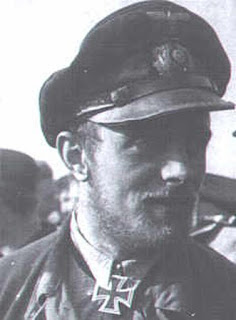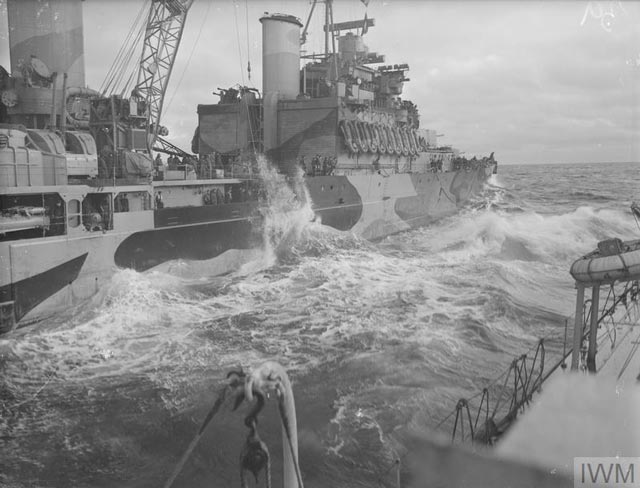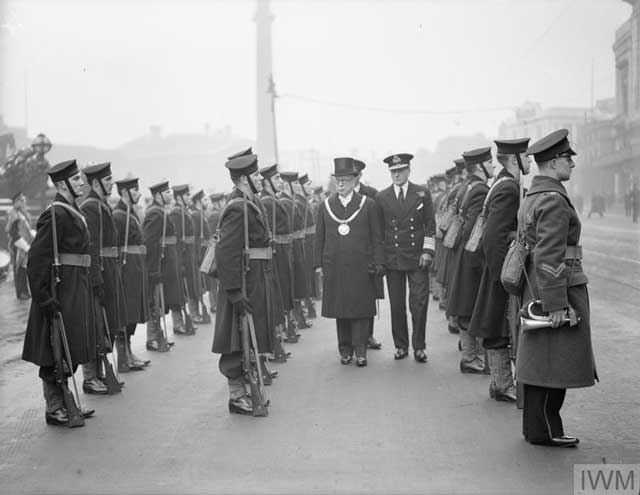Monday 9 March 1942
 |
| RAF warplanes spot the German battleship Tirpitz at sea, 9 March 1942. The Tirpitz appears to have just begun evasive maneuvers. Visible at the top is accompanying destroyer Friedrich Ihn. |
Some Dutch authorities manage to escape. The Lieutenant-Governor General of the Netherlands East Indies, Dr. van Mook, arrives in Adelaide. He promises that" "We are here to collect all the forces we can... There should be an end to destroying and retreating." However, Dutch strength in the Pacific effectively has ended for the time being.
The Japanese 35th Infantry Brigade under Major-General Kiyotake Kawaguchi completes the conquest of Borneo. There are still some Allied troops desperately holding out in isolated areas, but their position is hopeless.
 |
| Time Magazine of 9 March 1942 has many war pictures from around the world. At lower left is a photo of the "Flying Tigers" in Burma. |
As Japanese landings proceed at Lae and Salamaua, Allied Hudson bombers of No. 32 Squadron attack the convoys in the Huon Gulf, damaging Yokohama Maru and killing three and wounding eight. Japanese ship Asanagi also is lightly damaged off Lae. Meanwhile, Japanese aircraft bomb targets on New Guinea.
Japanese forces complete the occupation of Rangoon, which the British abandoned before they arrived. Rangoon was the key Allied transit hub for Lend-Lease shipments to China, so the Allies must figure out another route to get the supplies across the Himalayas. The British fly the 1st Battalion Royal Inniskilling Fusiliers to Magwe, Burma, where the British are trying to make a last stand in the country. These are the last British reinforcements to reach Burma.
 |
| A Republic P-43A Lancer 41-6687 in flight near Esler Airfield, Louisiana, 9 March 1942 (USAF). |
European Air Operations: During the day, RAF Bomber Command sends six Bostons on a Circus raid to bomb the Mazingarbe fuel depot without loss.
RAF Bomber Command sends another large mission out tonight. With the target being Essen, 187 bombers (187 aircraft, 136 Wellingtons, 21 Stirlings, 15 Hampdens, ten Manchesters, and five Halifaxes) use their Gee direction-finding equipment in poor weather conditions with thick ground haze. The bombers damage 72 buildings and destroy only two. In secondary raids, four bombers attack Emmerich and Oberhausen, nine Wellingtons and Stirlings bomb Boulogne (only four hit the target), and individual bombers attack Schipol and Soesterburg airfields. An additional five Hampdens lay mines in the Frisian Islands.
Overall, the RAF loses two Wellingtons and a Halifax.
While the Tirpitz does no damage to the Arctic convoys, the weather does. In rough seas near pack ice, 253-ton Soviet minesweeper Shera (formerly of the Royal Navy) capsizes in the Barents Sea.
 |
| Italian submarine Enrico Tazzoli in 1941. |
U-94 (Oblt. Otto Ites), on its second patrol out of Lorient, torpedoes and sinks independent 5152-ton Brazilian passenger/freighter SS Cayru about 130 miles off New York. There are 53 deaths and 36 survivors. There seems to be some disagreement about whether it is U-94 that scores this kill, but it is operating in that general area off Montauk Point on 9 March 1942. In any event, a U-boat definitely sinks SS Cayru.
 |
| U-boat Captain Otto Ites of U-94. He later became a dentist. |
 |
| "Paying out the oil fuel pipe from the cruiser HMS TRINIDAD which is hauled on board by the destroyer HMS FURY. Note the huge waves pounding the side of the cruiser." © IWM (A 7923). |
U-96 (Kptlt. Heinrich Lehmann-Willenbrock), on its eighth patrol out of St. Nazaire, torpedoes and sinks 4265-ton Norwegian freighter Tyr about 100 miles east of Halifax. The ship sinks within nine minutes. There are 13 dead and 18 survivors. Lehmann-Willenbrock on U-96 stops and gives the survivors directions to Sable Island.
 |
| The view from the Tirpitz on 9 March 1942 as it approaches safety in the Norwegian fjords after attacks by HMS Victorious. |
While all of this propaganda activity may seem peripheral and quaint, it has real-world consequences. President Roosevelt today again orders MacArthur to leave the Philippines aboard submarine USS Permit on 14 March, but this is overtaken by events almost immediately. The Japanese are monitoring press reports in the United States and, hearing increasing chatter that MacArthur should be put in charge in Australia, they increase their patrols in the Subic Bay area to prevent MacArthur's escape. Because of this, MacArthur's departure date is moved up and he is ordered to leave by high-speed torpedo boat rather than wait for the more secure submarine. The PT boats will take him to Mindanao as soon as possible, where he and his party will board three USAAF B-17 Flying Fortresses at Del Monte Field for the flight to Australia.
 |
| Heinrich Lehmann-Willenbrock of U-96. |
Angle/US Relations: Continuing their ongoing correspondence, President Roosevelt sends a cable to Winston Churchill ("Former Naval Person, London"). He informs the PM that he is sending Admiral Harold Stark as his new naval observer to replace Vice-Admiral Ghormley, who is going to the Pacific. Roosevelt complains that he is "concerned by the complexity of the present operational command setup to which is added equal complexity in the political setup." This opens up a topic that almost certainly catches Churchill by surprise.
FDR proposes to replace the "obsolescent" command arrangements and give the United States sole authority in the Pacific Theater of Operations. Basically, he proposes a complete US takeover of all decisionmaking in the Pacific, which obviously is a consequence of British losses in the Malay Peninsula, Singapore, and Hong Kong. Roosevelt outlines the concept of "offensives in northwesterly direction" on "Japan proper from Chinese or Aleutian or Siberian bases." This is the first hint of an Allied plan to go on the offensive in the Pacific, which at this time seems (and is) a bit premature and hopeful.
British/Greek Relations: The British and Greeks in Exile sign an agreement regarding the organization and employment of Greek troops.
 |
| German soldiers marching Jewish residents of Mielec off to the camps, 9 March 1942 (Federal Archive B 162 Bild-00427). |
A major reorganization ordered by President Roosevelt in an Executive Order of 28 February 1942 goes into effect today. A Zone of Interior (ZI) is established under General George C. Marshall as Chief of Staff. There are three autonomous commands: Army Ground Forces under Lieutenant General Lesley J. McNair, Army Air Forces under Lieutenant General Henry H. "Hap" Arnold, and Services of Supply (later designated as Army Service Forces) under Major General Brehon B. Somervell. The Army Air Forces (AAF) goes out of existence.
In addition to these moves, the division of responsibilities in the naval high command is clarified. Admiral King is made Chief of Naval Operations in place of Admiral Stark, who is given command of US naval forces in European waters.
 |
| "2nd Engineer Miss Victoria Drummond, MBE, MN, prepares for action against the enemy." 9 March 1942. © IWM (A 7842A). |
US Navy Submarine USS Swordfish arrives in Fremantle, Western Australia, carrying U.S. High Commissioner to the Philippine Islands Francis B. Sayre and his party. General MacArthur remains in the Philippines but has firm orders to depart soon.
US Army Engineers arrive in Dawson Creek, British Columbia, to work on the ALCAN highway. They will build the road to Fairbanks, Alaska.
Australian Military: The Australian high command had split the 7th Imperial Division, arriving from the Middle East, into two portions: part to go to Java, the rest to go to Adelaide. The men sent to Java today become prisoners of the Japanese, while the others arrive today in Adelaide.
 |
| Italian police at a conference in Berlin on 9 March 1942, surrounded by theater maps and under the all-seeing gaze of Adolf Hitler (Federal Archive Bild 121-1079). |
Hungary: Miklós Kállay becomes Prime Minister at the request of Hungarian Regent Miklós Horthy. Horthy and Kállay are very lukewarm allies of the Reich, and Kállay refuses to participate in such activities as rounding up Jewish residents. He also permits a surprising amount of political expression, including non-communist left-wing opposition. However, Kállay does support the war effort by sending troops to serve with the Wehrmacht. Since the Germans already are running short of manpower, Hitler does not interfere - for now.
 |
| A young woman glances at the official Reich Propaganda Ministry photographer as she is marched off to the camps in Mielec, Poland, 9 March 1942 (Federal Archive B 162 Bild-00439). |
Holocaust: Authorities in Slovakia order all Jewish residents to wear Yellow badges or "Stars of David."
 |
| German troops in Mielec, Poland, oversee the deportation of Jewish residents to camps, 9 March 1942 (Federal Archive B 162 Bild-00436). |
Future History: Dagoberto Campaneris Blanco is born in Pueblo Nuevo, Cuba. He develops into a speedy baseball shortstop, entering the Major Leagues in 1964 with the Kansas City Athletics. He ties a major league on his first day in the major leagues by hitting two home runs. His real offensive specialty, though, is stolen bases, at which he leads the American League six times. After the Athletics transfer to Oakland, Bert Campaneris (as he becomes known) is a key player on the champion teams of 1972-1974. He still holds the A's franchise record for games played at 1795, hits, and at-bats. "Campy" retires in 1983 with the New York Yankees and currently lives in Scottsdale, Arizona.
 |
| Danny Kaye on the cover of Playbill for the week of 9 March 1942. Also featured in the magazine are Eve Arden and Vivian Vance. |
March 1942
March 1, 1942: Second Battle of Java Sea
March 2, 1942: Huge Allied Shipping Losses at Java
March 3, 1942: Japan Raids Western Australia
March 4, 1942: Second Raid On Hawaii
March 5, 1942: Japan Takes Batavia
March 6, 1942: Churchill Assaults Free Speech
March 7, 1942: British Defeat in Burma
March 8, 1942: Rangoon Falls to Japan
March 9, 1942: Japanese Conquest of Dutch East Indies
March 10, 1942:US Navy attacks Japanese Landings at Lae
March 11, 1942: Warren Buffett's First Stock Trade
March 12, 1942: Japan Takes Java
March 13, 1942: Soviets Attack In Crimea Again
March 14, 1942: The US Leans Toward Europe
March 15, 1942: Operation Raubtier Begins
March 16, 1942: General MacArthur Gets His Ride
March 17, 1942: MacArthur Arrives in Australia
March 18, 1942: Japan Attacks In Burma
March 19, 1942: Soviets Encircled on the Volkhov
March 20, 1942: "I Shall Return," Says MacArthur
March 21, 1942: Germans Attack Toward Demyansk
March 22, 1942: Second Battle of Sirte
March 23, 1942: Hitler's Insecurity Builds
March 24, 1942: Bataan Bombarded
March 25, 1942: Chinese Under Pressure in Burma
March 26, 1942: Win Or Die, Vows MacArthur
March 27, 1942: The Battle of Suusari
March 28, 1942: The St. Nazaire Commando Raid
March 29, 1942: The Free Republic of Nias
March 30, 1942: Japanese-Americans Off Bainbridge Island
March 31, 1942: Japanese Seize Christmas Island
2020


























